A First Look at On The Ropes: Vintage Boxing Cards from the Jefferson R. Burdick Collection

Ray (Sugar) Robinson, from the Knock-Out Bubble Gum series (R401-5), issued by Leaf Gum Company, 1948. Commercial chromolithograph, sheet: 2 7/8 x 2 3/8 in. (7.3 x 6 cm). The Metropolitan Museum of Art, New York, The Jefferson R. Burdick Collection, Gift of Jefferson R. Burdick (Burdick 326, R401-5.19)
In the late 1940s, the Syracuse, New York–based electrician Jefferson R. Burdick began to donate his collection of more than three hundred thousand items of printed ephemera to The Met. While this voracious collector is best known today for his world-class collection of baseball cards, he was fairly indiscriminate about the types of ephemera he collected: postcards, cigar bands—even Dixie Cup lids made the cut. A new exhibition, On the Ropes: Vintage Boxing Cards from the Jefferson R. Burdick Collection, on view in gallery 773 through October 21, showcases the boxing cards in Burdick's collection, which date from the 1880s through the 1950s and feature some of the most celebrated boxers of the last two centuries.

William Hogarth (British, 1697–1764). A Midnight Modern Conversation, March 1732. Etching and engraving; second state of three, sheet: 13 7/16 x 18 7/16 in. (34.2 x 46.8 cm). The Metropolitan Museum of Art, New York, Harris Brisbane Dick Fund, 1932 (32.35[26])
A combat sport with ancient origins, boxing resurfaced as a popular form of entertainment in early eighteenth-century England. The modern iteration of the sport was established by James Figg (ca. 1690–1734), England's earliest known (and likely self-proclaimed) boxing champion. Figg, who garnered celebrity status in his day, founded a school for pugilism and opened an amphitheater in London that became the city's premier venue for sporting entertainment. He appeared in many of William Hogarth's satirical prints, including a drinking scene titled A Midnight Modern Conversation, in which Figg—sprawled in the foreground—and his companions are presented in various states of drunkenness.

Left: Thomas Rowlandson (British, 1757–1827). Six Stages of Marring a Face, May 29, 1792. Hand-colored etching, sheet: 10 3/16 x 14 3/16 in. (25.8 x 36.1 cm). The Metropolitan Museum of Art, New York, The Elisha Whittelsey Collection, The Elisha Whittelsey Fund, 1959 (59.533.464). Right: Thomas Rowlandson (British, 1757–1827). Six Stages of Mending a Face, Dedicated with Respect to the Right Hon-ble Lady Archer, May 29, 1792. Hand-colored etching, sheet: 10 13/16 x 15 1/8 in. (27.4 x 38.4 cm). The Metropolitan Museum of Art, New York, The Elisha Whittelsey Collection, The Elisha Whittelsey Fund, 1959 (59.533.463)
In Six Stages of Marring a Face, Thomas Rowlandson highlights the brutal aspects of the sport and pokes fun at its royal and aristocratic patronage by dedicating the print to "his grace the Duke of Hamilton." The print's pendant, Six Stages of Mending a Face, commemorates Lady Sarah Archer, who was often mocked by caricaturists for her heavy use of makeup.
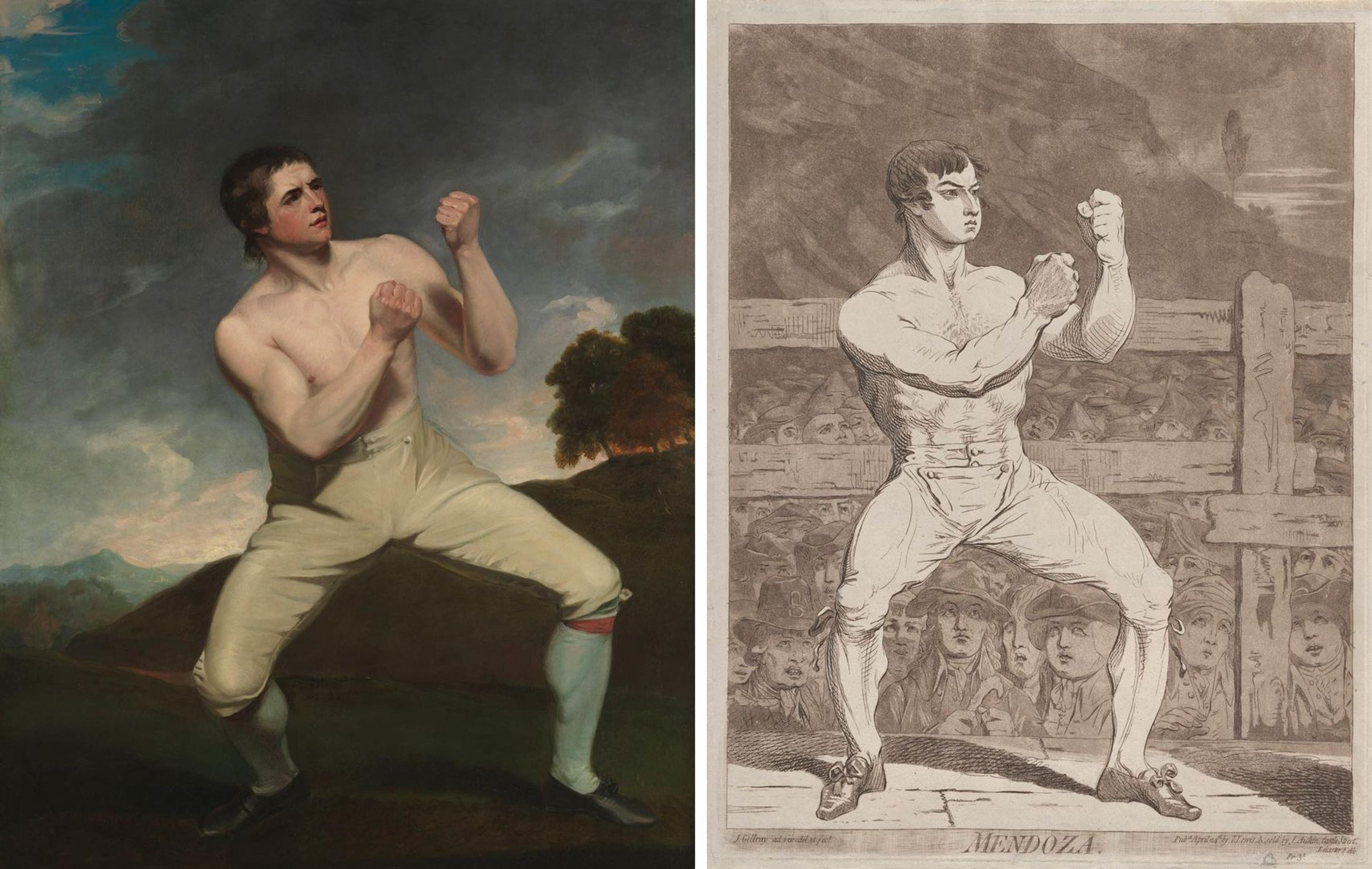
Left: John Hoppner (British, 1758–1810). Richard Humphreys, the Boxer. Oil on canvas, 55 3/4 x 44 1/4 in. (141.6 x 112.4 cm). The Metropolitan Museum of Art, New York, The Alfred N. Punnett Endowment Fund, 1953 (53.113). Right: James Gillray (British, 1756–1815). Mendoza, April 24, 1788. Etching and aquatint, sheet: 17 1/2 x 13 3/8 in. (44.5 x 34 cm). The Metropolitan Museum of Art, New York, The Elisha Whittelsey Collection, The Elisha Whittelsey Fund, 1966 (66.683.9)
From 1788 to 1790, British prize-fighter Richard Humphreys opposed his former student Daniel Mendoza in three well-publicized matches. While Humphreys, known in his time as "the Gentleman Boxer," was lauded for his elegant boxing style, Mendoza, who was of Portuguese-Jewish decent, was often referred to as "the Jew" in promotional materials. Such stereotyping illustrates the ways in which boxing was often cast as a battle of ethnicities, wherein athletes were regarded as representatives of whole communities—a trend that continues to the present day.

Left: Théodore Géricault (French, 1791–1824). Boxers, 1818. Lithograph, image: 13 15/16 x 16 1/2 in. (35.4 x 41.9 cm). The Metropolitan Museum of Art, New York, Rogers Fund, 1922 (22.63.28). Right: Attributed to George Cruikshank (British, 1792–1878). The Battle between Cribb and Molineaux, September 28, 1811, October 3, 1811. Hand-colored etching, plate: 9 15/16 x 13 7/8 in. (25.3 x 35.2 cm). The Metropolitan Museum of Art, New York, Gift of A. Hyatt Mayor, 1969 (69.635.2)
Théodore Géricault was one of the first artists to practice lithography—a method of printmaking that involves drawing an image with a wax crayon on a limestone surface. In Boxers, he harnessed the black-and-white technique and compositional strategies to accentuate the racial difference between the two central figures. Some believe the image depicts a fight between English boxer Tom Cribb and Tom Molineaux, a former American enslaved man. Though Géricault did not witness matches between the two men, all of which took place in England (Géricault made Boxers two years before traveling to England for the first time), he may have drawn inspiration from English prints in circulation, such as George Cruikshank's The Battle between Cribb and Molineaux.
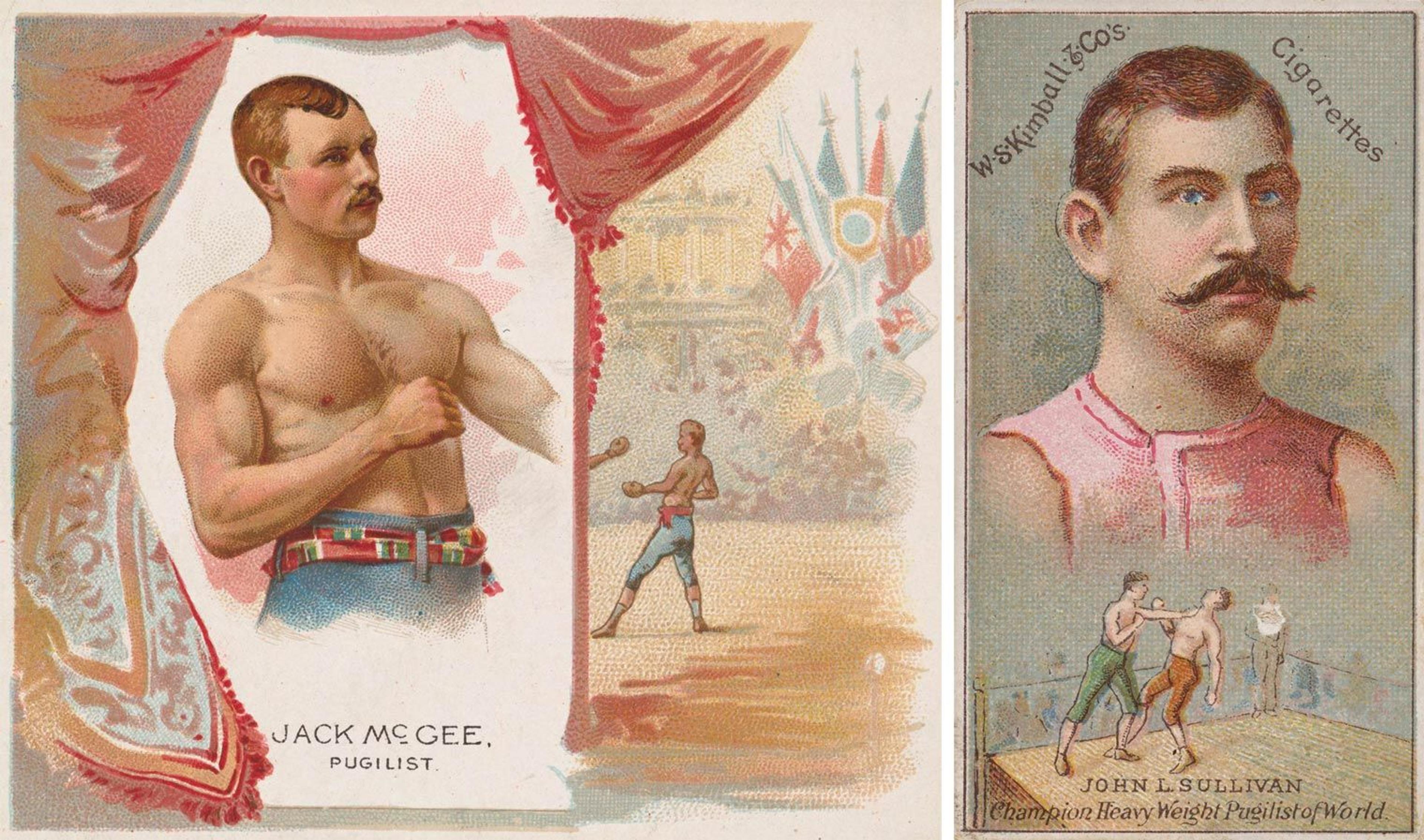
Left: Jack McGee, Pugilist, from World's Champions, second series (N43) for Allen & Ginter Cigarettes, 1888. Commercial lithograph, sheet: 2 15/16 x 3 1/4 in. (7.4 x 8.3 cm). The Metropolitan Museum of Art, New York, The Jefferson R. Burdick Collection, Gift of Jefferson R. Burdick (63.350.202.43.45). Right: John L. Sullivan, Champion Heavy Weight Pugilist of the World (detail), from the Champions of Games and Sports series (N184, Type 1) issued by W.S. Kimball & Co., 1887. Commercial color lithograph, sheet: 2 11/16 x 1 1/2 in. (6.8 x 3.8 cm). The Metropolitan Museum of Art, New York, The Jefferson R. Burdick Collection, Gift of Jefferson R. Burdick (63.350.216.184.7)
In the 1880s, tobacco companies in the United States leveraged the growing popularity of cigarettes, which were more portable than cigars, by inserting illustrated cards into cigarette packs. In addition to promoting products and developing brand loyalty, the collectible cards held a practical function: they stiffened soft packs so that cigarettes would not be damaged when stuffed into a smoker's pocket. The first boxing cards were included in tobacco card sets that also featured baseball players, rowers, pool players, and other "champions." John L. Sullivan, pictured above right, is known as both the last heavyweight champion of bare-knuckle boxing under the London Prize Ring Rules and the first heavyweight champion of gloved boxing under the Queensberry Rules.
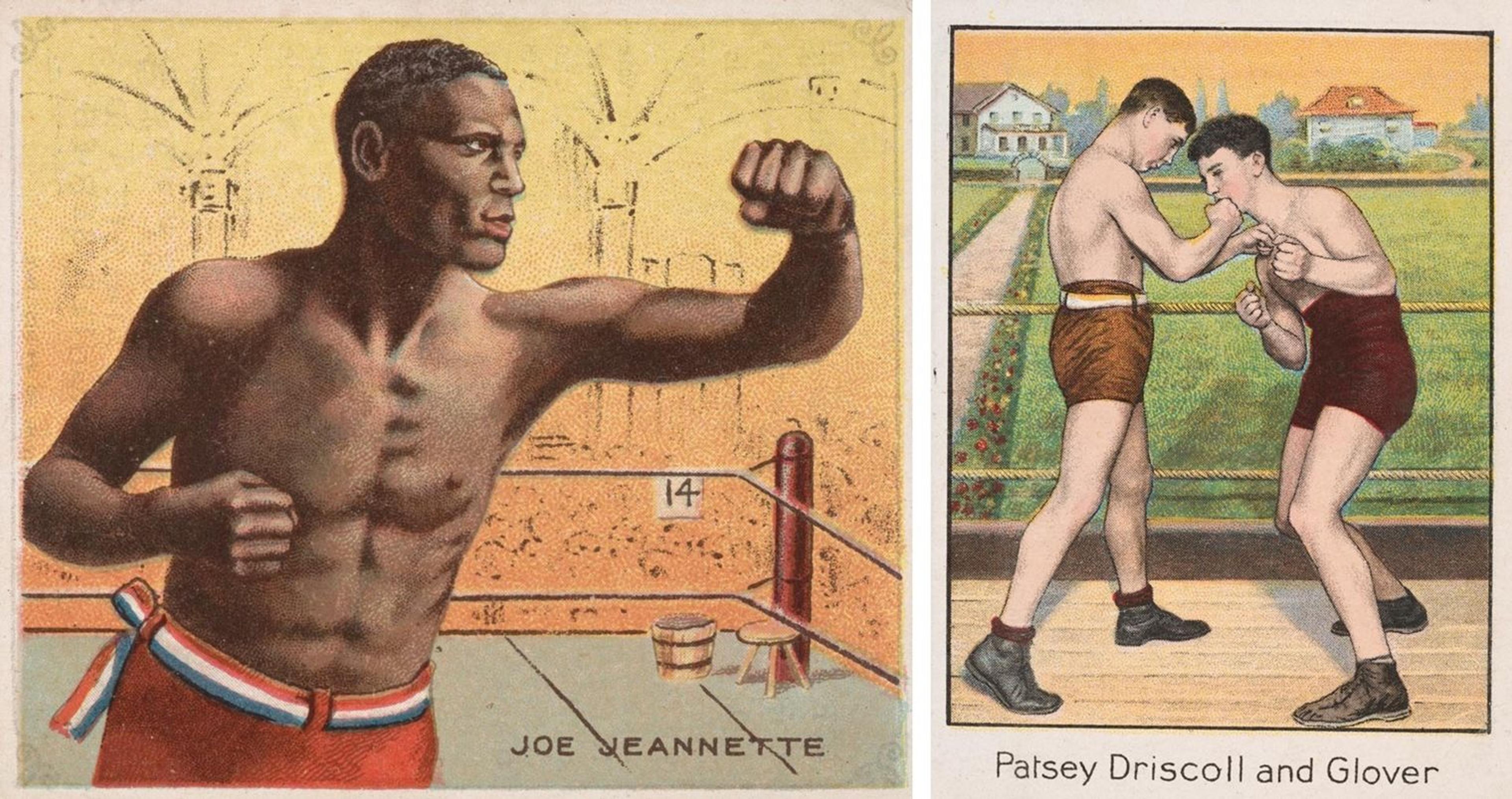
Left: Joe Jeannette, Boxing, from Mecca & Hassan Champion Athlete and Prize Fighter collection, issued by Mecca Cigarettes, 1910. Commercial color lithograph, sheet: 2 1/2 x 2 7/8 in. (6.4 x 7.3 cm). The Metropolitan Museum of Art, New York, The Jefferson R. Burdick Collection, Gift of Jefferson R. Burdick (63.350.247.218.85). Right: Patsey Driscoll and Glover, from the Champion Athlete and Prize Fighter series (T220), issued by Mecca and Tolstoi Cigarettes, 1910. Commercial color lithograph, sheet: 3 1/4 x 2 1/2 in. (8.3 x 6.3 cm). The Metropolitan Museum of Art, New York, The Jefferson R. Burdick Collection, Gift of Jefferson R. Burdick (63.350.247.220.44)
A number of tobacco manufacturers merged in 1890 to form the American Tobacco Company. The lack of competition in the tobacco industry that ensued resulted in a hiatus in the production of collectible trade cards. Boxing cards re-emerged around 1910, the year that formerly undefeated heavyweight champion James J. Jeffries came out of retirement to challenge Jack Johnson in what is commonly referred to as the first "fight of the century." Producers of caramels and other products responded to the resulting boxing craze in the US by issuing detailed, colorful cards.

Frans Masereel (Belgian, 1889–1972). The Boxer (Le Boxeur), 1921. Woodcut, block: 10 5/8 x 7 7/8 inches (27 x 20 cm). The Metropolitan Museum of Art, New York, Bequest of Scofield Thayer, 1984 (1984.1203.89). © 2018 Artists Rights Society (ARS), New York
Back in Europe, boxers and other celebrities of African descent enjoyed popularity during the early decades of the twentieth century, particularly in Paris. While the subject of Frans Masereel's The Boxer (Le Boxeur) is unknown and might not represent a specific individual, the man's suit, tie, top hat, and cane are reminiscent of the outfits donned by boxers such as Jack Johnson and Kid Chocolate, who was Cuban. These boxers—and Masereel—all spent time in the French capital.
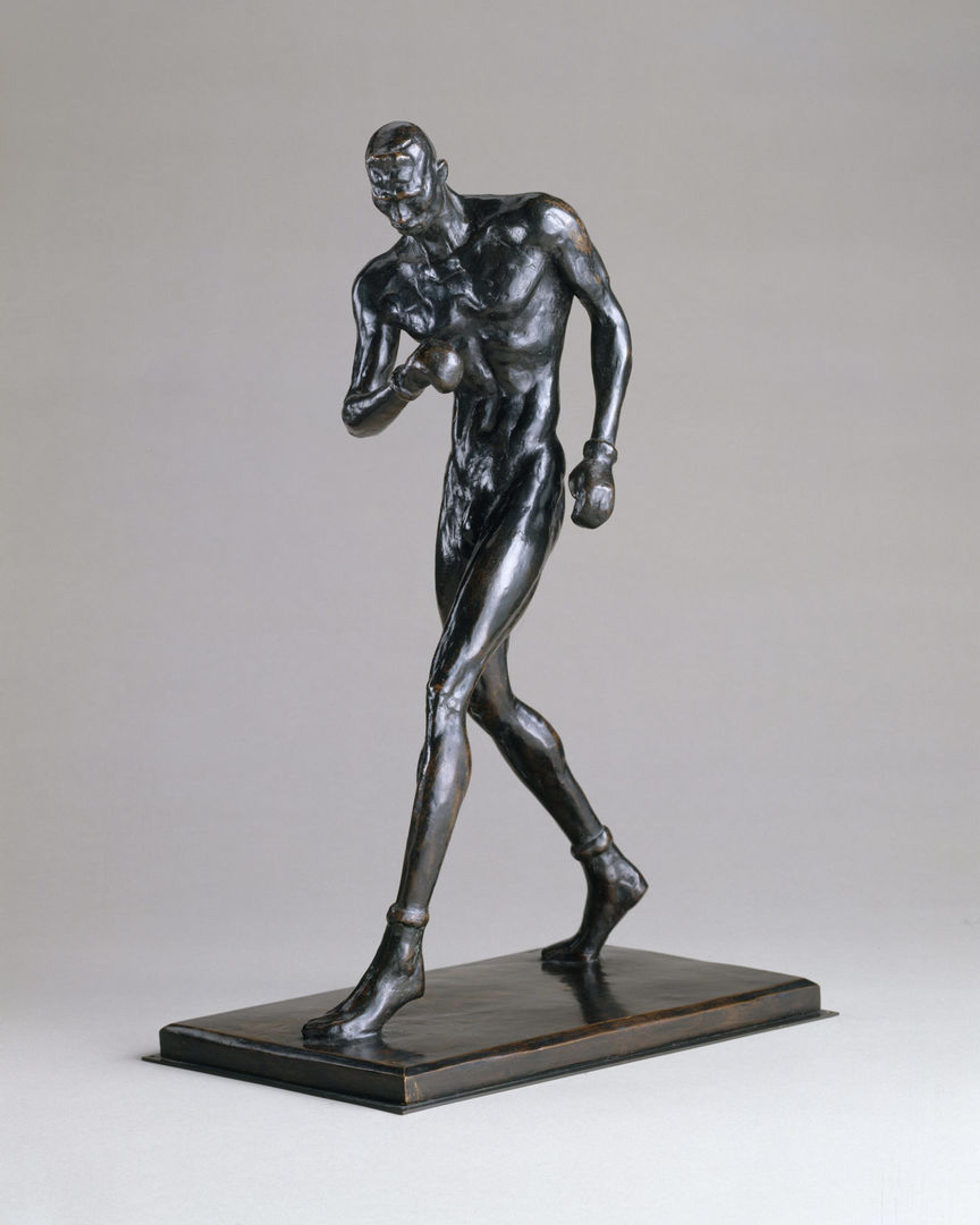
Richmond Barthé (American, 1901–1989). Boxer, 1942. Bronze, H. 18 1/4 x W. 7 x D. 12 in. (46.4 x 17.8 x 30.5 cm). The Metropolitan Museum of Art, New York, Rogers Fund, 1942 (42.180)
Kid Chocolate was the inspiration for Richmond Barthé's Boxer, a bronze sculpture that draws attention to the muscular yet lean physique of the featherweight boxer. Barthé, an African American sculptor who studied at the School of the Art Institute of Chicago, later recalled that Kid Chocolate "moved like a ballet dancer."
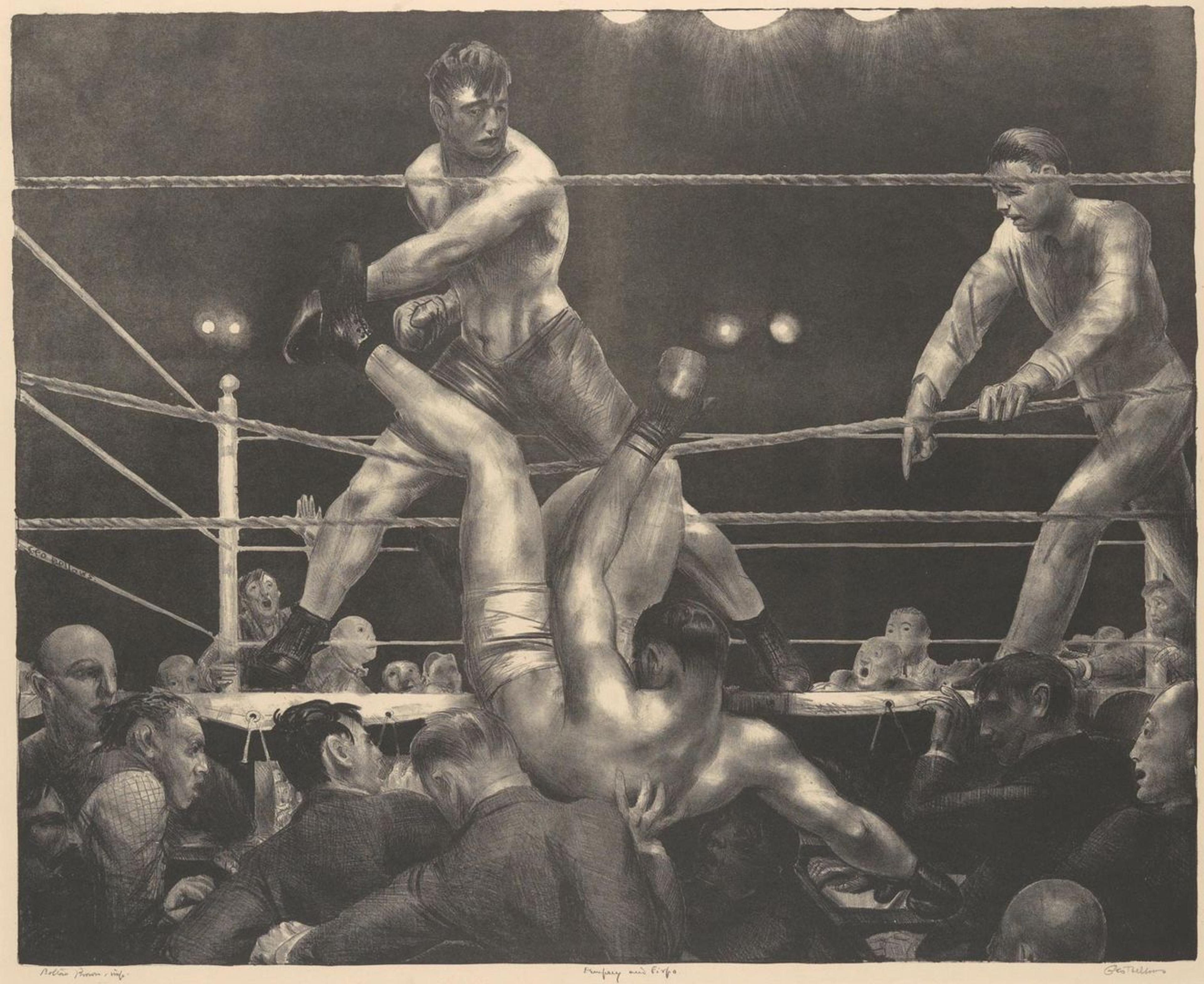
George Bellows (American, 1882–1925). Dempsey and Firpo, 1923–24. Lithograph, image: 18 1/8 x 22 3/8 in. (46 x 56.8 cm). The Metropolitan Museum of Art, New York, Harris Brisbane Dick Fund, 1925 (25.8.2)
Boxing was a favorite subject of American realist artist George Bellows. Dempsey and Firpo memorializes a match between Dempsey, called the "Manassa Mauler," and Firpo, the "Bull of the Pampas," held at the Polo Grounds in New York in September 1923 before eighty-two thousand spectators. Bellows's print focuses on the moment Dempsey was hoisted back into the ring, the legality of which was later questioned, resulting in controversy. The artist inserted his self-portrait in the lower left corner of the composition, with his attention cast on the most dramatic moment of the action-filled fight.
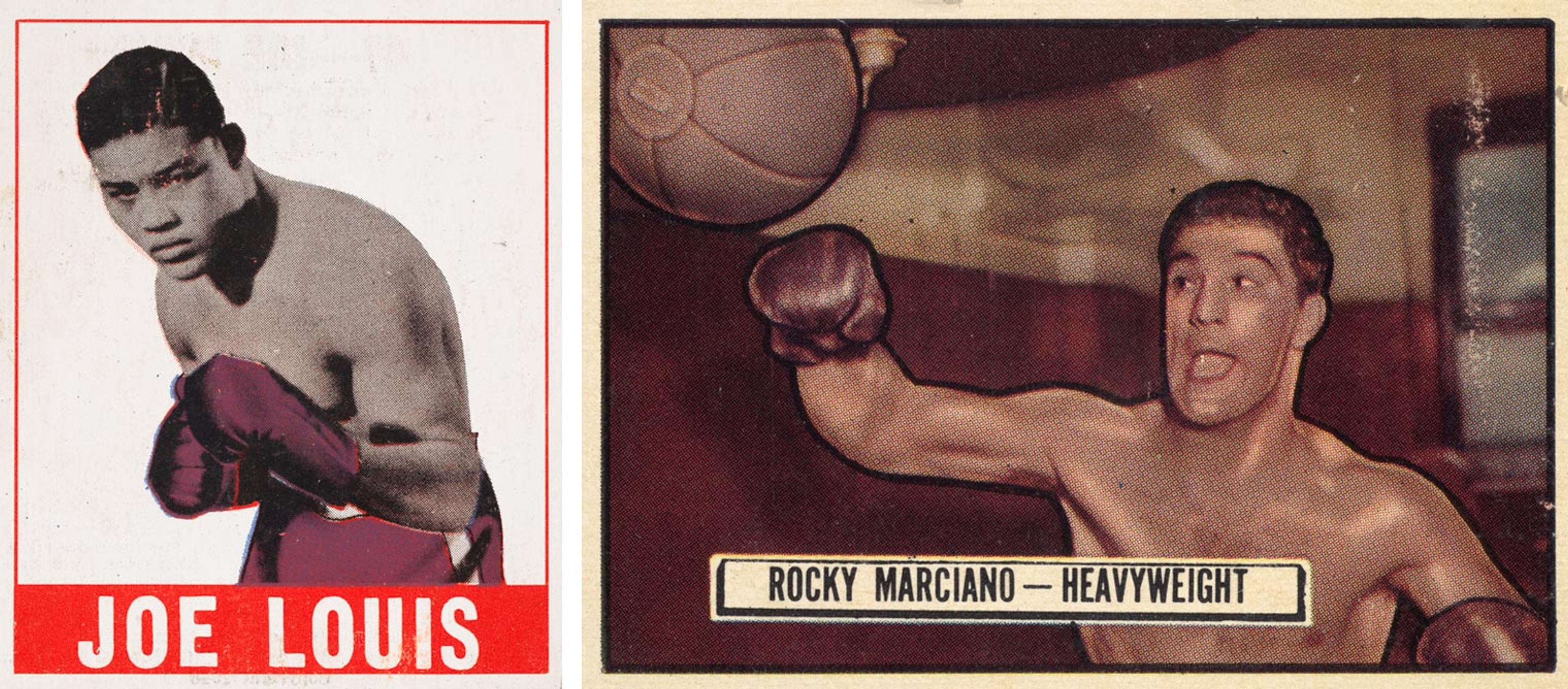
Left: Joe Louis, from the Knock-Out Bubble Gum series (R401-5), issued by Leaf Gum Company, 1948. Commercial chromolithograph, sheet: 2 7/8 x 2 3/8 in. (7.3 x 6 cm). The Metropolitan Museum of Art, New York, The Jefferson R. Burdick Collection, Gift of Jefferson R. Burdick (Burdick 326, R401-5.24). Right: Rocky Marciano, Heavyweight, from the Topps Ringside series (R411) issued by Topps Chewing Gum Company, 1951. Commercial color lithograph, sheet: 2 1/16 x 2 15/16 in. (5.2 x 7.5 cm). The Metropolitan Museum of Art, New York, The Jefferson R. Burdick Collection, Gift of Jefferson R. Burdick (Burdick 328, R411.84)
After World War II, two leading gum companies—Leaf and Topps—issued the largest boxing card set produced in three decades. Leaf's punchy cards included portraits of both historic and contemporary champions, including Jake LaMotta, who went by the nickname of "Raging Bull," and Joe Louis, generally regarded as one of the greatest heavyweight champions of all time. Louis was the first African American boxer to achieve the status of a national hero after he beat Germany's Max Schmeling in 1938. Topps's 1951 Ringside series included the rookie card of Rocky Mariano, the only world heavyweight champion to retire undefeated.
Featuring nearly 270 cards, On the Ropes is the first exhibition to include boxing cards from the Burdick Collection. Though it examines a previously unexplored aspect of this vast collection, it does much more than that: with the inclusion of works in other media from the The Met's holdings, the exhibition reveals the ubiquity of boxing imagery in the visual culture of the West since the early eighteenth century, highlighting the ways in which images of boxing have always foregrounded issues of nationality, race, ethnicity, celebrity, and masculinity.
Related Content
On the Ropes: Vintage Boxing Cards from the Jefferson R. Burdick Collection is on view at The Met Fifth Avenue through October 21, 2018.
Learn more about the Jefferson R. Burdick Collection and read an assortment of blog articles related to the collection.
Allison Rudnick
Associate Curator Allison Rudnick manages the Study Room for Drawings and Prints and oversees the ephemera collection. She joined the department as a research assistant in 2012 and has held positions at the print shop Harlan & Weaver and the Whitney Museum of American Art. Active in the field of contemporary printmaking, she is a frequent contributor to Art in Print and serves as treasurer for the Association of Print Scholars. She holds a BA from Connecticut College and an MPhil from the Graduate Center of the City University of New York, where she is a PhD candidate.